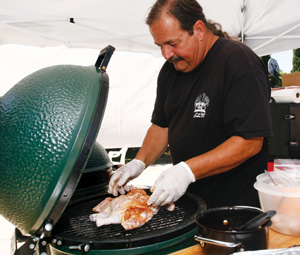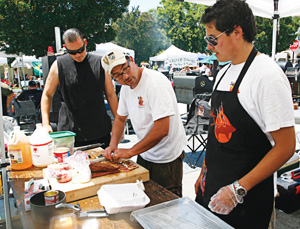THE WOOD SMOKE and aroma of sizzling meat wafting from Ric Gilbert’s backyard smell like those from any other suburban home on a lazy weekend afternoon. But Gilbert is no ordinary burger flipper.
Stepping into his San Jose backyard is like entering an Olympic training center for the barbecuing elite. Barbecue isn’t an Olympic sport, but for Gilbert and other competitive barbecuers in Silicon Valley it might as well be. Smoke and fire and meat are serious business. Gilbert is ranked no. 14 in the world and has been inducted into the Barbecue Hall of Fame.
To prepare for an upcoming barbecue contest, Gilbert and team member Ben Lobenstein erected a white canopy in his backyard under which to practice their skills on the grill. Or make that grills. Gilbert has a total of 10 barbecues scattered around his backyard. He started out on a classic Weber.
He went on to a Weber “bullet,” a blunt, torpedo-shaped device that’s better suited to smoking. (Barbecuing, by the way, is slow-cooking meat with indirect heat and smoke; grilling is cooking quickly and directly over a hot fire). He graduated to more sophisticated smokers and ultimately built his own rig, a trailer-mounted, smoke-blackened behemoth he affectionately calls “Sarah.” It’s named after Sarah Winchester because, like the legendary matron of the Winchester Mystery House, he just kept adding and adding new sections and features to the iron-clad, fire-breathing contraption.
But lately, Gilbert has developed a fondness for a stout, ceramic-walled barbecue called the Big Green Egg. If a Weber’s the VW bug of barbecues, the Big Green Egg is a Maserati. Or a Tesla. It’s so fuel-efficient and burns so slowly and evenly that he rarely has to add additional lumps of charcoal. They sell for about $1,000, and in spite of their simple, 1,000-year-old Chinese design, they are high-performance barbecuing machines. He owns three of them.
For Gilbert, barbecue isn’t just a way to cook meat. It’s a way of life
“It’s an obsession,” he says. “It’s a way of going over the top. It just sung to me. There’s something really primal about it.”
Smoke Signals
This being Silicon Valley, Gilbert, a 58-year-man with a mustache and hair pulled back into a ponytail, has married the low-tech smoker with some very new technology. After losing a mystery-meat competition in which contestants had to cook kangaroo meat, Gilbert makes sure he has an Internet connection at contests to make sure he can Google any technical questions that evade him.
“We’re all wired up now,” he says.
He also uses a device called the Stoker, a power draft system developed by Rock’s Bar-B-Que in Newark. The device automatically kicks on a fan to stoke the fire when the temperature falls below a pre-set temperature.
The device has an Ethernet connection that transmits messages about temperature via Twitter. It’s even possible to control the device remotely from a computer or a smart phone, but Gilbert isn’t the kind of guy to monitor his meat from afar. He is hands-on.
Today, his hands are on a slab of pork ribs that he has just pulled off the grill. In his estimation, the ribs were substandard. Too dry. While his style of cooking varies depending on where in the United States he is competing or who the judges are, there are certain standards set by the Kansas City Barbecue Society (KCBS) that he’s always shooting for.
KCBS sanctions and judges BBQ competitions across the United States and promotes barbecue as America’s national cuisine. It’s the largest society of barbecue enthusiasts in the world.
By KCBS standards, when you bite a rib it should leave a clean bite mark, but the meat should not fall off the bone. Meat that falls off the bone is overcooked. Instead, the meat should be offer slight resistance as it pulls away.
“We’ve been known to cook 10 racks of ribs in order to serve six good ones,” Gilbert says.
For me, the ribs were outstanding even if they were a shade too dry. The meat was succulent, juicy and carried a beautiful glaze from Gilbert’s delicious homemade tangy-sweet barbecue sauce.
In competition, competitors cook to a different standard. Judges evaluate barbecue on the basis of texture, flavor and presentation. All KCBS-certified judges must swear an oath before they are allowed to pass judgment:
“I do solemnly swear to objectively and subjectively evaluate each Barbeque meat that is presented to my eyes, my nose, my hands and my palate. I accept my duty to be an Official KCBS Certified Judge, so that truth, justice, excellence in Barbeque and the American Way of Life may be strengthened and preserved forever.”
But because judges sample so much barbecue in a contest, he or she may only take one or two bites of each contestant’s entry before moving on to the next competitor. That means competitive ‘cuers like Gilbert have to get everything right in just one bite, and therefore their meats are intensely flavored, more hyperdelicious that what you would find in a barbecue restaurant.
“You want to cook something that’s going to dance on the judge’s tongue,” Gilbert explains.
Fire in the Belly
For Gilbert, the secret to great barbecue is threefold: fire control, using good meat and having a pleasing “signature,” the spices and marinades that make the product your own. But he also says barbecuing at this level where competitors compete for sometimes thousands of dollars against dozens of other teams and spend almost 24 hours tending their fires right up until the judging is an intensely mental game, too. Those not fit for the rigors of competition get burned.
“When most people think of barbecue they think of beer-guzzling bubbas in the backyard with a Weber,” he says.
Technically, Gilbert did have beer on hand in his backyard among the relics of old Webers, but I would not call him a bubba. Gilbert, a program director of a special education school, takes a more cerebral approach to barbecue than most. He’s noticed, for example, that when people like his barbecue sauce they smack their lips and aerate their mouth as if they were tasting wine. He also looks at the composition of judges, noting their training and their age and considers what their reference points of barbecue may be.
“It’s a moving target,” he says. “What won last year might not win this year. It really is a mental game.”
The Disciple
Gilbert holds an informal contest in his backyard once a year where teams can hone their craft and get extensive feedback from judges. At official contests, all competitors get is a numerical score. It was at one of these backyard scrimmages that Ryan Pang met Gilbert. If Gilbert is Silicon Valley’s barbecue guru, Ryan Pang is one his disciples.
“He’s got the passion,” says Gilbert. “He’s been bitten by the bug.”
Pang and his Bad S Barbecue team (the S is for Sunnyvale) are up-and-comers on the barbecue scene. Pang is a loquacious, bespectacled private chef who graduated with honors from the Culinary Institute of America.
Pang has also worked at Manresa, Maggiano’s, Liquid Sushi and other Silicon Valley restaurants. His food service knowhow gives him an edge in the barbecue world. Although he and his friends have been competing for less than a year, they have already collected some impressive winnings. Inspired by the TV show BBQ Pit Masters and Gilbert’s barbecue get-togethers, he and his buddies decided to go pro and compete.
“We just kind of ran with it from there,” he says.
Like many barbecuers, it took a while for Pang and his crew to settle on the right equipment. They started with a Brinkman barbecue, a simple, entry-level unit.
“It’s the cheapest smoker you can buy,” he says. “It’s like a tin can.”
They learned the intricacies of smoke and fire control and soon needed to upgrade. After trying out different smokers, they decided to build their own. Making heavy use of Craigslist, they cobbled together a smoker made from a 1940s General Electric refrigerator, an old water heater, an insert fireplace and a discarded steel bed frame for a fire grate.
“Even if we’re not winning we’re going to have a great conversation piece,” he says
The pieced-together Frankenstein contraption is really quite a beauty, and it makes some great barbecue. (Check out the team’s website at badsbbq.com for photos). Pang and team received two “grand champion” awards at contests in Redding and San Jose and third place at the Alameda County Fair for ribs and chicken.
“What we’ve done far surpasses any expectations of what we’d do,” he says.
The team has also picked up sponsorships from Mary’s Organic Chicken and Lazzari charcoal. The highest praise came from Gilbert who told Pang he had “refrigerator envy” upon seeing their rig.
“He’s sort of like our idol,” says Pang.
In spite of their success they got skunked at a contest held in Campbell last month in conjunction with the Big Bands and Barbecue festival. Pang and more than a dozen other teams were bested by the Lord of the Ribs, a barbecue team made up of four brothers. They got second place in the chicken category, but Pang was disappointed with their results. Since the event was not a KCBS-sanctioned event, Pang spent a lot of his energies helping the organizers put the event together, maybe at the expense of his barbecue.
I tried his tri-tip and it tasted just fine to me, well crusted and flavorful on the outside and juicy tender inside. For the “open category” in which contestants can submit anything of their choosing, Pang rolled sliced tri-tip with horseradish cream, crispy onions and pickled red onions on top. Tasted like a winner to me.
The event had the feel of giant tailgate party. In between tending the fires and checking their meat, teams lolled about in lawn chairs drinking bottled water and beer while trying to stay cool.
There’s a lot of camaraderie among the teams, too. Pang picked up the meat for all his adversaries and even sold them some wood.
In the end, San Jose’s Lord of the Ribs received its first-ever grand champion award to top them all, an honor given to the team with the top scores over all categories.
“It was awesome,” says team leader Ellias Van Ekelenburg.
The team uses a pellet-fed smoker that some barbecuers look down upon because of its ease of use. Barbecuers who use pellet smokers are called “pellet heads.” But Van Ekelenburg and his fellow pellet heads won the day. Each brother on the team has his specialty. Van Ekelenburg’s is barbecued chicken, a dish that takes him two hours to prepare, not counting the cooking time.
“It just looks amazing. A lot of judges will eat with their eyes. It starts from there.”
For his part, Pang has a few more events he and his team are planning to compete in this summer. Next year, he is planning to step up into the big leagues and compete in higher-profile contests with bigger cash prizes.
“We’re just trying to cover our costs,” Pang says. “We’re not trying to turn a profit.”
But for the full-time professional chef turned part-time professional barbecuer, the thrill of the grill fulfills a higher calling.
“The biggest thing about food for me is satisfying other people,” he says. “It’s what I want to do … and when I do it I want to do it right.”





